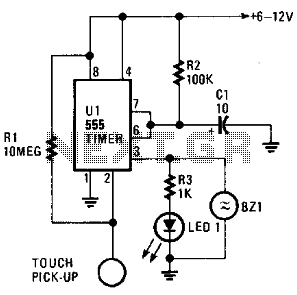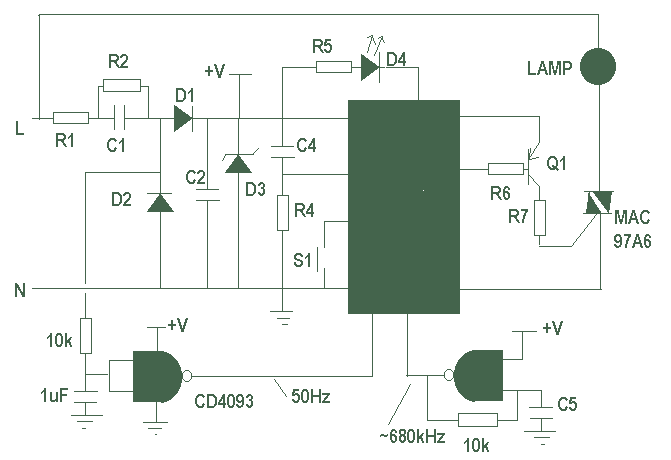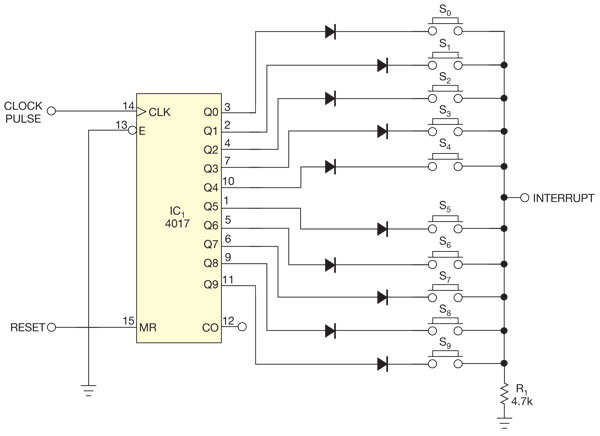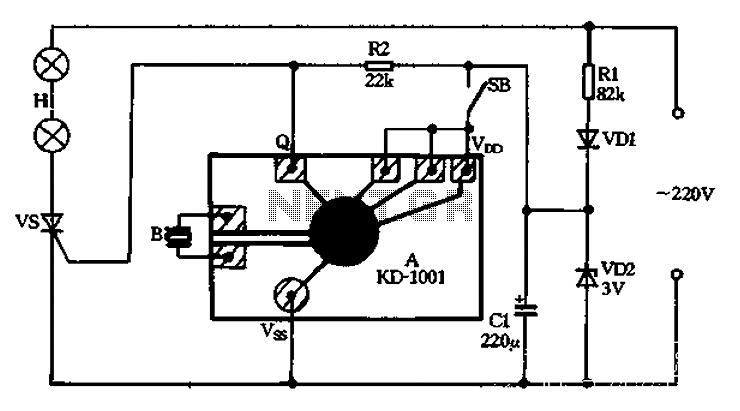
By BH-SK-1 produced a single bond Touch light switch
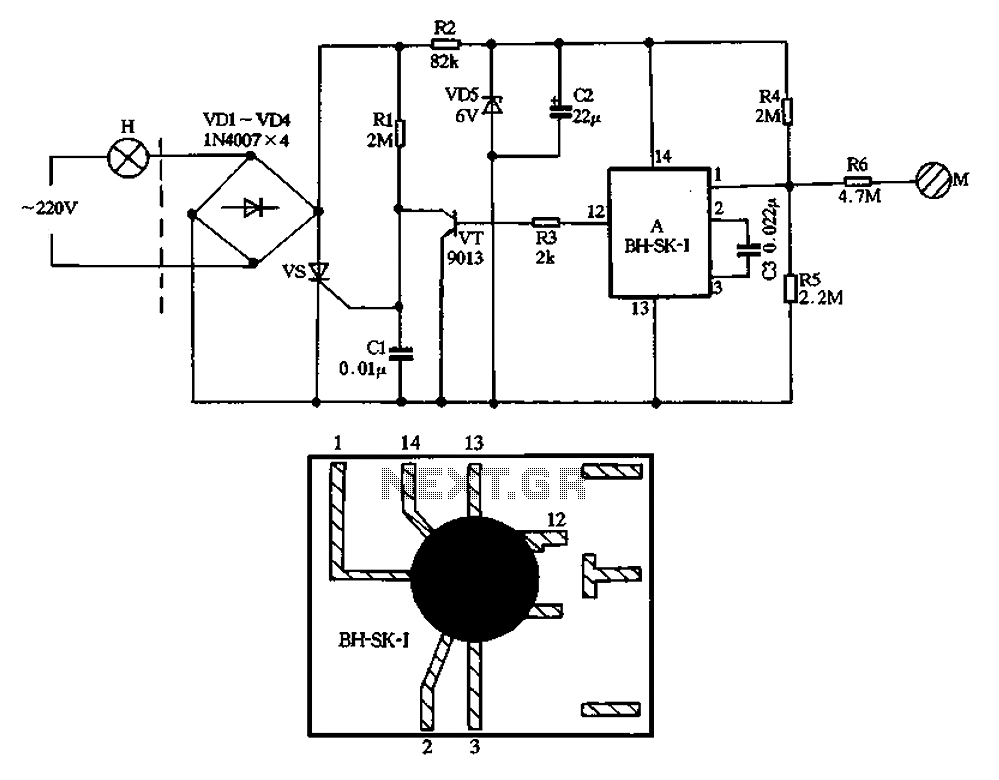
The BH-SK-I is a touch light switch circuit that integrates a single bond voice integrated circuit. The circuit is divided into two sections: the left section represents the general lighting lines, while the right section illustrates the touch switch. This design allows for easy replacement of conventional mechanical switches without altering the existing interior wiring. The main route consists of an SCR and diodes VD1 to VD4, which form part of the voice integrated circuit control loop. The components R2 and C2 create a simple regulator circuit using VD5 to provide a 6V DC voltage. Resistors R4 and R5 create a voltage divider that supplies a slight bias voltage of approximately 1/2 VDD to the input pin, enhancing the sensitivity of the circuit. The activation of the SCR depends on the state of the transistor VT. When VT is in the off state, current flows through resistor R1, activating the circuit and illuminating the lamp. Conversely, when VT conducts, it shorts the gate to ground, turning the lamp off. The voice IC operates in a bistable mode, with the output level at pin 12 determining whether the lamp is on or off. A high output at pin 12 causes VT to conduct, turning off the lights. To turn on the lights, a touch on the electrode sheet M generates a noise signal that is transmitted through resistor R6 to the input at pin 1. This signal triggers the internal circuit, flipping the bistable state, resulting in a low output at pin 12, which stops VT and turns on the lamp. Touching the lower electrode sheet M will trigger the circuit again, causing the output at pin 12 to go high, which turns off the lamp. The circuit maintains functionality even when the lamp is lit, as the voltage across C2 drops to approximately 3V, allowing the CMOS circuit to operate with minimal power consumption.
The BH-SK-I touch light switch circuit is designed to provide a seamless transition from traditional mechanical switches to a modern touch-sensitive interface. The integration of a voice IC allows for enhanced functionality, enabling users to control lighting with simple touch gestures. The circuit architecture employs a combination of SCRs and diodes to create a reliable control mechanism, ensuring that the lamp operates efficiently under varying conditions.
The voltage regulator formed by R2, C2, and VD5 ensures that the circuit receives a stable 6V DC supply, which is critical for the performance of the voice IC. The voltage divider created by R4 and R5 is essential for setting the bias voltage at the input pin, allowing for sensitivity adjustments that can cater to different environments and user preferences.
The bistable operation of the voice IC is a key feature that allows for intuitive control of the lamp. The output from pin 12 directly influences the state of the transistor VT, which acts as a switch for the lamp. The ability to toggle the state of the lamp with a simple touch on electrode sheet M provides a user-friendly experience, while the internal processing of the noise signal ensures that accidental touches do not lead to unintended operation.
In terms of power management, the circuit's CMOS design is advantageous, as it minimizes power consumption while maintaining operational integrity. The voltage drop across capacitor C2 during lamp operation indicates that the circuit can sustain itself even with reduced power levels, making it suitable for applications where energy efficiency is a priority.
Overall, the BH-SK-I touch light switch circuit exemplifies a modern approach to lighting control, combining ease of use with advanced electronic components to deliver a reliable and efficient solution for both residential and commercial applications. BH-SK-I with the voice of a single bond integrated circuit fabrication touch light switch circuit shown in Figure, the dashed line in Figure 3-40 left section for the general l ighting lines, the right part is the touch switch. Be seen by its ordinary mechanical switches, Foreign cited only two stages, so you can easily replace the ordinary switch without changing the original interior wiring. Switch back to the main route SCR vs diode VD1 ~ VD4 and composition, voice integrated circuits control loop.
R2, and C2 form VD5 simple regulator circuit, for the manifold provides 6V DC voltage, resistors R4, R5 partial pressure of the composition is for the manifold l input pin provides slightly. 1/2 VDD bias voltage, so that the manifold in a more sensitive state. SCR vs turned on or not, depending on the switching state of the transistor VT. When the VT is off state, vs through resistor R1 and the opening of the current administration to obtain contact, namely H lamp is lit; when the VT in the conduction state.
VT vs gate is shorted to ground. vs in the off state, the lamp goes out. Won voice IC is in a bistable operation mode, its output level is 12 feet high low determines the lamp is lit or extinguished. If the 12-pin output high, VT conduction, vs off, the lights go out. Turn on the lights when needed, as long as your fingers touch the electrode sheet M. Human induced noise signal is applied to the manifold via a resistor R6 to the input end of the l foot, after the internal manifold circuit processing, the internal flip-flop flip, 12-pin output low, so transistor VT CD stop, vs open, lights on the point H shell.
Such as touching a lower electrode sheet M, the manifold internal bistable trigger fork flipping once, 12 feet high output, VT conduction, vs off, the lamp H goes out. Therefore, by hand contact electrodes M, you can turn on and off operation. In vs opened, when the lamp is lit, C2 both ends of the voltage will drop to around 3V, because the BH-SK- I belong CMOS circuit power consumption is minimal, it can still maintain normal work, so do not worry about it.
The BH-SK-I touch light switch circuit is designed to provide a seamless transition from traditional mechanical switches to a modern touch-sensitive interface. The integration of a voice IC allows for enhanced functionality, enabling users to control lighting with simple touch gestures. The circuit architecture employs a combination of SCRs and diodes to create a reliable control mechanism, ensuring that the lamp operates efficiently under varying conditions.
The voltage regulator formed by R2, C2, and VD5 ensures that the circuit receives a stable 6V DC supply, which is critical for the performance of the voice IC. The voltage divider created by R4 and R5 is essential for setting the bias voltage at the input pin, allowing for sensitivity adjustments that can cater to different environments and user preferences.
The bistable operation of the voice IC is a key feature that allows for intuitive control of the lamp. The output from pin 12 directly influences the state of the transistor VT, which acts as a switch for the lamp. The ability to toggle the state of the lamp with a simple touch on electrode sheet M provides a user-friendly experience, while the internal processing of the noise signal ensures that accidental touches do not lead to unintended operation.
In terms of power management, the circuit's CMOS design is advantageous, as it minimizes power consumption while maintaining operational integrity. The voltage drop across capacitor C2 during lamp operation indicates that the circuit can sustain itself even with reduced power levels, making it suitable for applications where energy efficiency is a priority.
Overall, the BH-SK-I touch light switch circuit exemplifies a modern approach to lighting control, combining ease of use with advanced electronic components to deliver a reliable and efficient solution for both residential and commercial applications. BH-SK-I with the voice of a single bond integrated circuit fabrication touch light switch circuit shown in Figure, the dashed line in Figure 3-40 left section for the general l ighting lines, the right part is the touch switch. Be seen by its ordinary mechanical switches, Foreign cited only two stages, so you can easily replace the ordinary switch without changing the original interior wiring. Switch back to the main route SCR vs diode VD1 ~ VD4 and composition, voice integrated circuits control loop.
R2, and C2 form VD5 simple regulator circuit, for the manifold provides 6V DC voltage, resistors R4, R5 partial pressure of the composition is for the manifold l input pin provides slightly. 1/2 VDD bias voltage, so that the manifold in a more sensitive state. SCR vs turned on or not, depending on the switching state of the transistor VT. When the VT is off state, vs through resistor R1 and the opening of the current administration to obtain contact, namely H lamp is lit; when the VT in the conduction state.
VT vs gate is shorted to ground. vs in the off state, the lamp goes out. Won voice IC is in a bistable operation mode, its output level is 12 feet high low determines the lamp is lit or extinguished. If the 12-pin output high, VT conduction, vs off, the lights go out. Turn on the lights when needed, as long as your fingers touch the electrode sheet M. Human induced noise signal is applied to the manifold via a resistor R6 to the input end of the l foot, after the internal manifold circuit processing, the internal flip-flop flip, 12-pin output low, so transistor VT CD stop, vs open, lights on the point H shell.
Such as touching a lower electrode sheet M, the manifold internal bistable trigger fork flipping once, 12 feet high output, VT conduction, vs off, the lamp H goes out. Therefore, by hand contact electrodes M, you can turn on and off operation. In vs opened, when the lamp is lit, C2 both ends of the voltage will drop to around 3V, because the BH-SK- I belong CMOS circuit power consumption is minimal, it can still maintain normal work, so do not worry about it.
